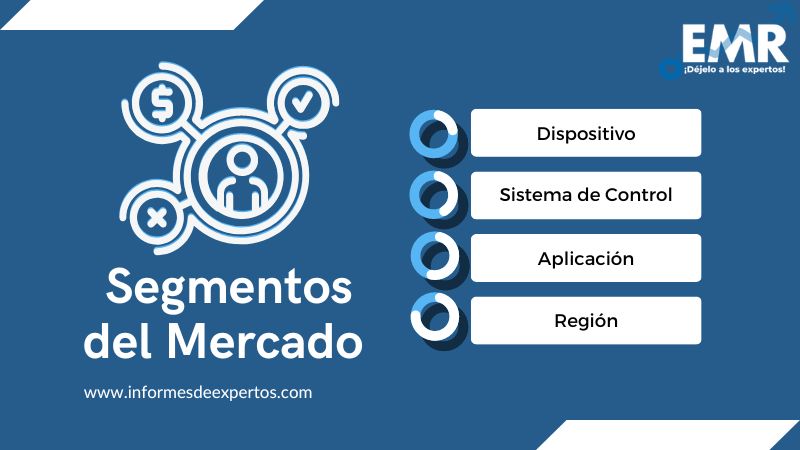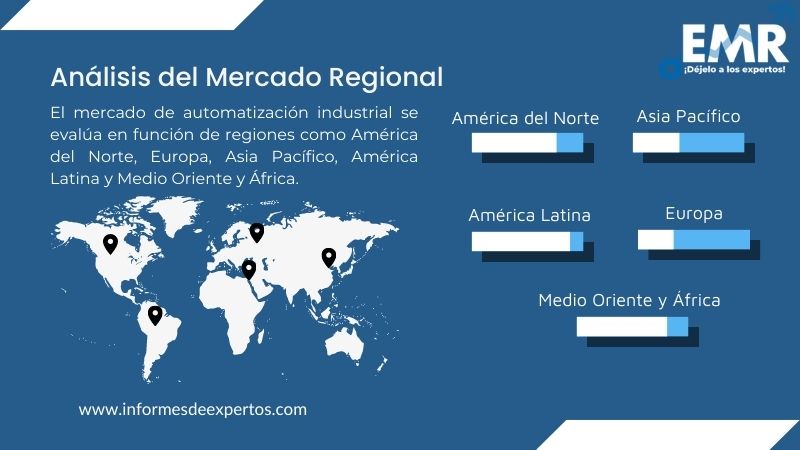Informes

Mercado Global de Automatización Industrial – Por Dispositivo (Visión Artificial, Robótica, Sensores, Movimiento y Accionamientos, Relés e Interruptores, Otros); Por Sistema de Control (Control de Supervisión y Adquisición de Datos (SCADA), Sistema de Control Distribuido (DCS), Controlador Lógico Programable (PLC), Otros); Por Aplicación (Industria Discreta, Industria de Procesos); Por Región (América del Norte, Europa, Asia Pacífico, América Latina, Medio Oriente y África); Dinámica del Mercado (2025-2034) y Panorama Competitivo
Visión General del Mercado de Automatización Industrial
El mercado de automatización industrial alcanzó un valor de USD 170,26 mil millones en el año 2024. Se estima que el mercado crecerá a una tasa de crecimiento anual compuesta del 5,1% entre 2025 y 2034, para alcanzar un valor de 266,40 mil millones de USD en 2034.

La automatización industrial implica el uso de tecnología y sistemas de control para automatizar procesos industriales y maquinaria, normalmente en entornos de fabricación y producción. Esto puede incluir el uso de maquinaria como robots, sistemas transportadores y controladores lógicos programables para aumentar la eficiencia, reducir costes y mejorar el control de calidad. Las tecnologías digitales, como la IA y el IoT, también se utilizan para recopilar y analizar datos con fines de conocimiento y optimización.
El mercado de automatización industrial está experimentando un crecimiento significativo, impulsado por la necesidad de aumentar la productividad, los avances tecnológicos y un mayor énfasis en la sostenibilidad. En términos de sistemas de control, el mercado de la automatización industrial está dominado por los controladores lógicos programables (PLC), que se utilizan para automatizar procesos y mejorar la eficiencia. Con la creciente demanda de automatización y la adopción de nuevas tecnologías como la inteligencia artificial y el Internet de las cosas, se espera que el mercado de la automatización industrial continúe su trayectoria de crecimiento, y nuevas tendencias como el uso de twin digitales y la robótica avanzada seguirán dando forma a la industria.
Norteamérica cuenta con un sector industrial maduro y alberga algunas de las mayores empresas del mundo. Las empresas de la región, muy centradas en la innovación y la tecnología, están invirtiendo mucho en automatización, robótica y tecnologías avanzadas. Europa es también un mercado bien establecido para las aplicaciones industriales, con un fuerte enfoque en la sostenibilidad y la eficiencia energética. Asia-Pacífico es el mercado de automatización industrial de más rápido crecimiento, impulsado por la rápida industrialización y urbanización de la región.
Factores Vitales que Impactan al Mercado de Automatización Industrial
- Automatización y robótica: La demanda de automatización y robótica en diversas industrias va en aumento, ya que aportan varias ventajas, como el aumento de la productividad, la reducción de los costes laborales y la mejora de la eficiencia. Se están utilizando robots industriales para realizar tareas repetitivas y se están implantando sistemas autónomos en la fabricación, la logística y el transporte.
- Internet de las cosas (IoT): El IoT es una red de dispositivos interconectados que pueden comunicarse entre sí e intercambiar datos. Proporciona capacidades de supervisión y análisis en tiempo real para procesos industriales, lo que permite a las empresas mejorar sus operaciones y reducir el tiempo de inactividad.
- Eficiencia energética y sostenibilidad: Cada vez se presta más atención a la eficiencia energética y la sostenibilidad en el sector industrial, lo que lleva a la adopción de fuentes de energía renovables y tecnologías energéticamente eficientes. Esto se debe a la preocupación por el medio ambiente, las normativas gubernamentales y la necesidad de reducir los costes operativos, lo que hace crecer el tamaño del mercado de la automatización industrial.
- Tecnologías avanzadas: La aparición de tecnologías avanzadas como la inteligencia artificial, el aprendizaje automático y el mantenimiento predictivo está mejorando las capacidades de las aplicaciones industriales. Estas tecnologías permiten a las empresas supervisar y analizar datos en tiempo real, identificar posibles problemas antes de que se produzcan y optimizar sus operaciones.
Automatización Industrial: Análisis del Mercado

Según los dispositivos, el mercado se segmenta en:
- Visión Artificial
- Robótica
- Sensores
- Movimiento y Accionamientos
- Relés e Interruptores
- Otros
Por sistema de control, el mercado se clasifica en:
- Control de Supervisión y Adquisición de Datos (SCADA)
- Sistema de Control Distribuido (DCS)
- Controlador Lógico Programable (PLC)
- Sistema de Ejecución de Fabricación (MES)
- Gestión del Ciclo de Vida del Producto (PLM)
- Planificación de Recursos Empresariales (ERP)
- Interfaz Hombre-Máquina (HMI)
- Otros
En términos de aplicación, el mercado se segrega en:
- Industria Discreta
- Industria de Procesos
El segmento de la industria discreta se subdivide a su vez en automoción, envasado, procesamiento de alimentos, textil y otros. Por otro lado, la industria de procesos se clasifica en química, energía, petróleo y gas, sanidad y farmacia, plásticos y otros.
El mercado de automatización industrial se evalúa en función de regiones como América del Norte, Europa, Asia Pacífico, América Latina y Medio Oriente y África.

Panorama Competitivo
La dinámica de automatización industrial indica los cambios con respecto a los nuevos participantes y la rivalidad que muestran. Los actores del mercado están inculcando nuevos cambios con el fin de atender a la creciente base de consumidores y derivar nuevos cambios positivos para marcar el potencial del producto para prosperar. Las principales empresas son:
- Siemens AG
- Emerson Electric Co.
- ABB Ltd.
- Rockwell Automation, Inc.
- Mitsubishi Electric Corporation
- Schneider Electric
- Texas Instruments Incorporated
- Otros
El informe de Informes de Expertos (IDE) expone las tendencias fundamentales que dan lugar a un ritmo de crecimiento positivo en el mercado global de automatización industrial. Además, incluye factores que influyeron exponencialmente en la dinámica del mercado durante el período histórico (2018-2024) y factores que proliferarán aún más la trayectoria de crecimiento en el período de pronóstico (2025-2034). El informe describe los principales segmentos por dispositivos, sistema de control, aplicación, y regiones clave, así como los principales líderes del sector que están provocando cambios en las pautas de compra. Mediante el análisis de las cinco fuerzas de Porter y el análisis FODA, se esbozan los retos a los que se enfrentan los nuevos competidores.
Alcance del Mercado
|
Características del Informe |
Detalles |
|
Año Base de la Estimación: |
2024 |
|
Datos Históricos: |
2018-2024 |
|
Datos de Pronóstico: |
2025-2034 |
|
Alcance del Informe: |
Tendencias Históricas y Previsiones del Mercado, Impulsores y Limitantes de
|
|
Desglose por Dispositivo: |
|
|
Desglose por |
|
|
Desglose por Aplicación: |
|
|
Desglose por Región: |
|
|
Dinámica del Mercado: |
|
|
Panorama Competitivo: |
|
|
Empresas Cubrietas: |
|
Informes de tendencias:
Mercado Colombiano de Aceite de Palma
Mercado de Agricultura Vertical en México
Mercado de Agroquímicos en México
Mercado de Agua Embotellada en México
*En Informes de Expertos siempre nos esforzamos por brindarle la información más reciente. Los números de artículo son solo indicativos y pueden diferir del informe real.
Language of the Report – English
Sin embargo, el informe puede estar disponible en español por un costo adicional.
1 Preface
2 Report Coverage – Key Segmentation and Scope
3 Report Description
3.1 Market Definition and Outlook
3.2 Properties and Applications
3.3 Market Analysis
3.4 Key Players
4 Key Assumptions
5 Executive Summary
5.1 Overview
5.2 Key Drivers
5.3 Key Developments
5.4 Competitive Structure
5.5 Key Industrial Trends
6 Snapshot
6.1 Global
6.2 Regional
7 Opportunities and Challenges in the Market
8 Global Industrial Automation Market Analysis
8.1 Key Industry Highlights
8.2 Global Industrial Automation Historical Market (2018-2024)
8.3 Global Industrial Automation Market Forecast (2025-2034)
8.4 Global Industrial Automation Market by Devices
8.4.1 Machine Vision
8.4.1.1 Historical Trend (2018-2024)
8.4.1.2 Forecast Trend (2025-2034)
8.4.2 Robotics
8.4.2.1 Historical Trend (2018-2024)
8.4.2.2 Forecast Trend (2025-2034)
8.4.3 Sensors
8.4.3.1 Historical Trend (2018-2024)
8.4.3.2 Forecast Trend (2025-2034)
8.4.4 Motion and Drives
8.4.4.1 Historical Trend (2018-2024)
8.4.4.2 Forecast Trend (2025-2034)
8.4.5 Relays and Switches
8.4.5.1 Historical Trend (2018-2024)
8.4.5.2 Forecast Trend (2025-2034)
8.4.6 Others
8.5 Global Industrial Automation Market by Control System
8.5.1 Supervisory Control and Data Acquisition (SCADA)
8.5.1.1 Historical Trend (2018-2024)
8.5.1.2 Forecast Trend (2025-2034)
8.5.2 Distributed Control System (DCS)
8.5.2.1 Historical Trend (2018-2024)
8.5.2.2 Forecast Trend (2025-2034)
8.5.3 Programmable Logic Controller (PLC)
8.5.3.1 Historical Trend (2018-2024)
8.5.3.2 Forecast Trend (2025-2034)
8.5.4 Manufacturing Execution System (MES)
8.5.4.1 Historical Trend (2018-2024)
8.5.4.2 Forecast Trend (2025-2034)
8.5.5 Product Lifecycle Management (PLM)
8.5.5.1 Historical Trend (2018-2024)
8.5.5.2 Forecast Trend (2025-2034)
8.5.6 Enterprise Resource Planning (ERP)
8.5.6.1 Historical Trend (2018-2024)
8.5.6.2 Forecast Trend (2025-2034)
8.5.7 Human Machine Interface (HMI)
8.5.7.1 Historical Trend (2018-2024)
8.5.7.2 Forecast Trend (2025-2034)
8.5.8 Others
8.6 Global Industrial Automation Market by Application
8.6.1 Discrete Industry
8.6.1.1 Historical Trend (2018-2024)
8.6.1.2 Forecast Trend (2025-2034)
8.6.1.3 Breakup by Industry
8.6.1.3.1 Automotive
8.6.1.3.2 Packaging
8.6.1.3.3 Food Processing
8.6.1.3.4 Textile
8.6.1.3.5 Others
8.6.2 Process Industry
8.6.2.1 Historical Trend (2018-2024)
8.6.2.2 Forecast Trend (2025-2034)
8.6.2.3 Breakup by Industry
8.6.2.3.1 Chemical
8.6.2.3.2 Power
8.6.2.3.3 Oil and Gas
8.6.2.3.4 Healthcare and Pharma
8.6.2.3.5 Plastic
8.6.2.3.6 Others
8.7 Global Industrial Automation Market by Region
8.7.1 North America
8.7.1.1 Historical Trend (2018-2024)
8.7.1.2 Forecast Trend (2025-2034)
8.7.2 Europe
8.7.2.1 Historical Trend (2018-2024)
8.7.2.2 Forecast Trend (2025-2034)
8.7.3 Asia Pacific
8.7.3.1 Historical Trend (2018-2024)
8.7.3.2 Forecast Trend (2025-2034)
8.7.4 Latin America
8.7.4.1 Historical Trend (2018-2024)
8.7.4.2 Forecast Trend (2025-2034)
8.7.5 Middle East and Africa
8.7.5.1 Historical Trend (2018-2024)
8.7.5.2 Forecast Trend (2025-2034)
9 North America Industrial Automation Market Analysis
9.1 United States of America
9.1.1 Historical Trend (2018-2024)
9.1.2 Forecast Trend (2025-2034)
9.2 Canada
9.2.1 Historical Trend (2018-2024)
9.2.2 Forecast Trend (2025-2034)
10 Europe Industrial Automation Market Analysis
10.1 United Kingdom
10.1.1 Historical Trend (2018-2024)
10.1.2 Forecast Trend (2025-2034)
10.2 Germany
10.2.1 Historical Trend (2018-2024)
10.2.2 Forecast Trend (2025-2034)
10.3 France
10.3.1 Historical Trend (2018-2024)
10.3.2 Forecast Trend (2025-2034)
10.4 Italy
10.4.1 Historical Trend (2018-2024)
10.4.2 Forecast Trend (2025-2034)
10.5 Others
11 Asia Pacific Industrial Automation Market Analysis
11.1 China
11.1.1 Historical Trend (2018-2024)
11.1.2 Forecast Trend (2025-2034)
11.2 Japan
11.2.1 Historical Trend (2018-2024)
11.2.2 Forecast Trend (2025-2034)
11.3 India
11.3.1 Historical Trend (2018-2024)
11.3.2 Forecast Trend (2025-2034)
11.4 ASEAN
11.4.1 Historical Trend (2018-2024)
11.4.2 Forecast Trend (2025-2034)
11.5 Australia
11.5.1 Historical Trend (2018-2024)
11.5.2 Forecast Trend (2025-2034)
11.6 Others
12 Latin America Industrial Automation Market Analysis
12.1 Brazil
12.1.1 Historical Trend (2018-2024)
12.1.2 Forecast Trend (2025-2034)
12.2 Argentina
12.2.1 Historical Trend (2018-2024)
12.2.2 Forecast Trend (2025-2034)
12.3 Mexico
12.3.1 Historical Trend (2018-2024)
12.3.2 Forecast Trend (2025-2034)
12.4 Others
13 Middle East and Africa Industrial Automation Market Analysis
13.1 Saudi Arabia
13.1.1 Historical Trend (2018-2024)
13.1.2 Forecast Trend (2025-2034)
13.2 United Arab Emirates
13.2.1 Historical Trend (2018-2024)
13.2.2 Forecast Trend (2025-2034)
13.3 Nigeria
13.3.1 Historical Trend (2018-2024)
13.3.2 Forecast Trend (2025-2034)
13.4 South Africa
13.4.1 Historical Trend (2018-2024)
13.4.2 Forecast Trend (2025-2034)
13.5 Others
14 Market Dynamics
14.1 SWOT Analysis
14.1.1 Strengths
14.1.2 Weaknesses
14.1.3 Opportunities
14.1.4 Threats
14.2 Porter’s Five Forces Analysis
14.2.1 Supplier’s Power
14.2.2 Buyer’s Power
14.2.3 Threat of New Entrants
14.2.4 Degree of Rivalry
14.2.5 Threat of Substitutes
14.3 Key Indicators for Demand
14.4 Key Indicators for Price
15 Value Chain Analysis
16 Competitive Landscape
16.1 Market Structure
16.2 Company Profiles
16.2.1 Siemens AG
16.2.1.1 Company Overview
16.2.1.2 Product Portfolio
16.2.1.3 Demographic Reach and Achievements
16.2.1.4 Certifications
16.2.2 Emerson Electric Co.
16.2.2.1 Company Overview
16.2.2.2 Product Portfolio
16.2.2.3 Demographic Reach and Achievements
16.2.2.4 Certifications
16.2.3 ABB Ltd.
16.2.3.1 Company Overview
16.2.3.2 Product Portfolio
16.2.3.3 Demographic Reach and Achievements
16.2.3.4 Certifications
16.2.4 Rockwell Automation, Inc.
16.2.4.1 Company Overview
16.2.4.2 Product Portfolio
16.2.4.3 Demographic Reach and Achievements
16.2.4.4 Certifications
16.2.5 Mitsubishi Electric Corporation
16.2.5.1 Company Overview
16.2.5.2 Product Portfolio
16.2.5.3 Demographic Reach and Achievements
16.2.5.4 Certifications
16.2.6 Schneider Electric
16.2.6.1 Company Overview
16.2.6.2 Product Portfolio
16.2.6.3 Demographic Reach and Achievements
16.2.6.4 Certifications
16.2.7 Texas Instruments Incorporated
16.2.7.1 Company Overview
16.2.7.2 Product Portfolio
16.2.7.3 Demographic Reach and Achievements
16.2.7.4 Certifications
16.2.8 Others
17 Key Trends and Developments in the Market
List of Key Figures and Tables
1. Global Industrial Automation Market: Key Industry Highlights, 2018 and 2034
2. Global Industrial Automation Historical Market: Breakup by Device (USD Billion), 2018-2024
3. Global Industrial Automation Market Forecast: Breakup by Device (USD Billion), 2025-2034
4. Global Industrial Automation Historical Market: Breakup by Control System (USD Billion), 2018-2024
5. Global Industrial Automation Market Forecast: Breakup by Control System (USD Billion), 2025-2034
6. Global Industrial Automation Historical Market: Breakup by Application (USD Billion), 2018-2024
7. Global Industrial Automation Market Forecast: Breakup by Application (USD Billion), 2025-2034
8. Global Industrial Automation Historical Market: Breakup by Region (USD Billion), 2018-2024
9. Global Industrial Automation Market Forecast: Breakup by Region (USD Billion), 2025-2034
10. North America Industrial Automation Historical Market: Breakup by Country (USD Billion), 2018-2024
11. North America Industrial Automation Market Forecast: Breakup by Country (USD Billion), 2025-2034
12. Europe Industrial Automation Historical Market: Breakup by Country (USD Billion), 2018-2024
13. Europe Industrial Automation Market Forecast: Breakup by Country (USD Billion), 2025-2034
14. Asia Pacific Industrial Automation Historical Market: Breakup by Country (USD Billion), 2018-2024
15. Asia Pacific Industrial Automation Market Forecast: Breakup by Country (USD Billion), 2025-2034
16. Latin America Industrial Automation Historical Market: Breakup by Country (USD Billion), 2018-2024
17. Latin America Industrial Automation Market Forecast: Breakup by Country (USD Billion), 2025-2034
18. Middle East and Africa Industrial Automation Historical Market: Breakup by Country (USD Billion), 2018-2024
19. Middle East and Africa Industrial Automation Market Forecast: Breakup by Country (USD Billion), 2025-2034
20. Global Industrial Automation Market Structure
El mercado de automatización industrial alcanzó un valor de USD 170,26 mil millones en 2024.
Se prevé que el mercado de automatización industrial registre un crecimiento a una CAGR del 5,1% durante el periodo de pronóstico 2025-2034.
El mercado de automatización industrial está experimentando un crecimiento significativo debido a la creciente demanda de automatización y robótica, la creciente adopción de IoT y tecnologías relacionadas, y el creciente enfoque en la eficiencia energética y la sostenibilidad.
El mercado de automatización industrial está evolucionando rápidamente, con empresas que buscan aprovechar las nuevas tecnologías y enfoques para mejorar la eficiencia, reducir costes y aumentar la sostenibilidad como tendencia principal.
Los importantes dispositivos son visión artificial, robótica, sensores, movimiento y accionamientos, relés e interruptores, y otros.
Control de supervisión y aquisición de datos (SCADA), sistema de control distribuido (DCS), controlador lógico programable (PLC), sistema de ejecución de fabricación (MES), gestión del ciclo de vida del producto (PLM), planificación de recursos empresariales (ERP), interfaz hombre-máquina (HMI), y otros son los sistemas de control.
Las dos aplicaciones incluyen industria discreta e industria de procesos.
Las prominentes regiones son América del Norte, Europa, Asia Pacífico, América Latina y Medio Oriente y África.
Siemens AG, Emerson Electric Co., ABB Ltd., Rockwell Automation, Inc., Mitsubishi Electric Corporation, Schneider Electric, Texas Instruments Incorporated, y otros son las mayores empresas.
La automatización industrial es un componente esencial de los procesos industriales modernos y evoluciona continuamente junto con los avances tecnológicos, como el Internet de las cosas (IoT), el aprendizaje automático y otras tecnologías emergentes.
Se anticipa que el mercado de automatización industrial experimentará un crecimiento considerable durante el periodo de pronóstico de 2025-2034 para alcanzar los 266,40 mil millones de USD en 2034.
Excel Data Set
-
Datos completos en formato Excel para un usuario
-
Impresión no permitida
-
Entrega por Email
-
Personalización limitada gratuita (pre-venta)Soporte de analista post ventaDescuento del 50% en la Próxima ActualizaciónUsuario Único
USD3199USD2999-
Restringido a un usuario
-
Solo una impresión
-
Disponible en PDF
-
Personalización limitada gratuita (pre-venta)Soporte de analista post ventaDescuento del 50% en la Próxima ActualizaciónCinco Usuarios
USD4199USD3999-
Restringido a cinco usuarios
-
Una impresión por usuario
-
Disponible en PDF
-
Personalización limitada gratuita (pre-venta)
-
Soporte de analista post venta
-
Descuento del 50% en la Próxima Actualización
Multiusuario
USD5199USD4999-
Usuarios ilimitados dentro de la organización
-
Impresiones ilimitadas
-
Disponible en PDF
-
Personalización limitada gratuita (pre-venta)
-
Soporte de analista post venta
-
Descuento del 50% en la Próxima Actualización
Póngase en Contacto¿Cualquier Pregunta? Hable con un Analista
Solicitar una MuestraVer una Muestra
Solicitar PersonalizaciónSe le olvidó algo? Pregunte Ahora
¿Por qué Informes de Expertos?La Gente Adecuada
Somos técnicamente excelentes, estratégicos, prácticos, experimentados y eficientes; nuestros analistas son cuidadosamente seleccionados en función de tener los atributos correctos para trabajar con éxito y ejecutar proyectos basados en sus expectativas.
Metodología Correcta
Aprovechamos nuestra tecnología de vanguardia, nuestro acceso a bases de datos confiables y nuestro conocimiento de los modelos actuales utilizados en el mercado para ofrecerle soluciones de investigación que se adapten a sus necesidades y lo pongan a la vanguardia.
Precio Justo
Realizamos una investigación exhaustiva y de calidad superior a precios razonables, inigualables y que demuestran nuestra comprensión de su estructura de recursos. Además, ofrecemos descuentos atractivos en nuestros próximos informes.
Apoyo Adecuado
Nuestro equipo de analistas expertos está a su disposición entera para ofrecerle resultados óptimos personalizados para satisfacer sus necesidades precisas dentro del plazo especificado y ayudarlo a comprender mejor la industria.
Informes SimilaresEl crecimiento del mercado de la seguridad en Brasil está impulsado por el aumento de los casos de actividades fraudulentas, el incremento del terrorismo transfronterizo y el creciente uso de tecnolo...
La cuota de mercado de ciberseguridad en Argentina está expandiendo debido al aumento de las amenazas cibernéticas, la creciente penetración de Internet, y las iniciativas gubernamentales activas p...
El crecimiento del mercado latinoamericano de instrumentación y automatización de procesos puede atribuirse a la creciente automatización y digitalización en todas las industrias para mejorar la e...
El mercado de ciberseguridad en México muestra un crecimiento exponencial debido al aumento en la penetración de internet, el incremento en el número de ciberdelitos y la integración de tecnologí...
El mercado global de equipos automatizados de manipulación de materiales está experimentando tendencias como un mayor uso de cobots, integración de IA/ML, AMR y drones, software basado en la nube, ...
Newsletter





